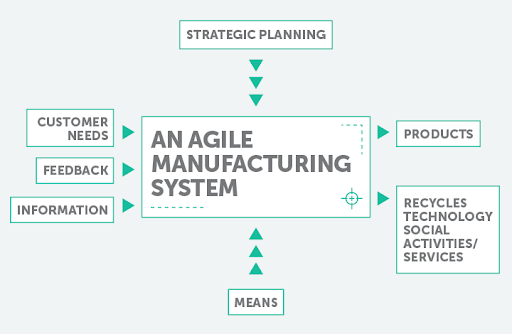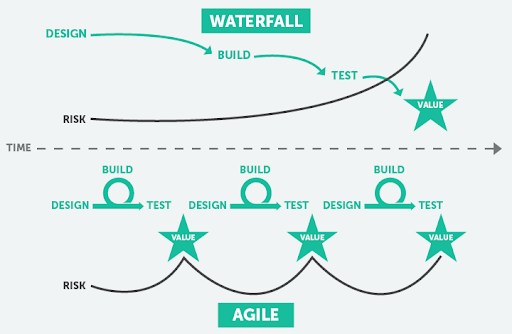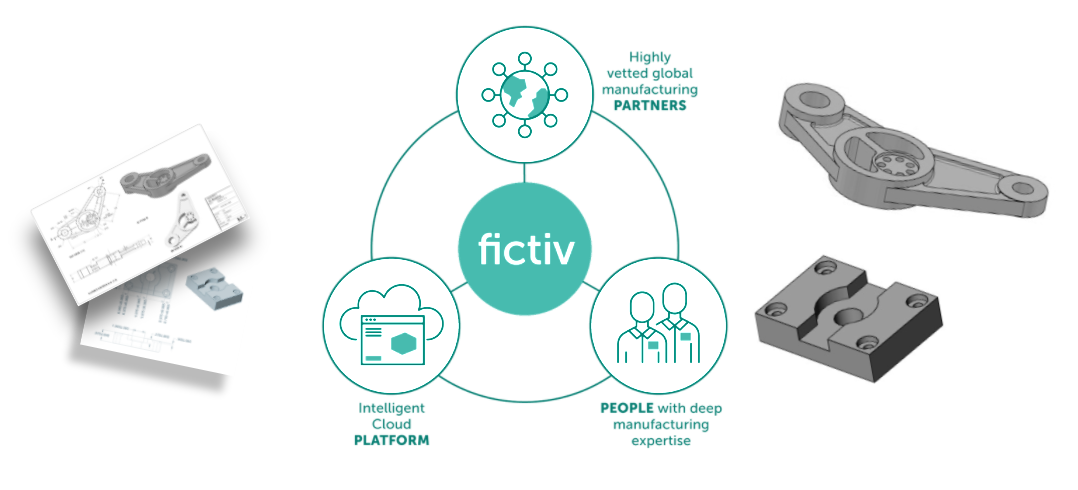Time to read: 6 min
When you think of agility, something that comes to mind may be the agility competitions for dogs that are broadcast for interested parties to cheer their favorite dog on. You might recall the obstacles the dogs must navigate (typically 14-20), in order to secure a qualifying score or win. Dog agility competitions are serious, with strict rules for faults, time, weight, class, and even disqualifications. The world of agile manufacturing follows a parallel scheme to our beloved agility dog competitions, with many obstacles and necessary human intervention to keep the mechanics running smoothly.

Manufacturing is currently a rapidly changing industry. We are amid a manufacturing revolution, an era of growth and advancement that some experts refer to as Industry 4.0 or the Fourth Industrial Revolution. Regardless of the term you want to use to define it, manufacturers must develop an approach that facilitates this change. Enter the agile manufacturing approach. Agile manufacturing involves producing product with agility. Agility can be defined as the power of moving quickly and easily, like the fast and skilled movements of a dog in a dog agility competition. An Agile Manufacturing System is one which is resilient, provides faster access time to value, and often an integrated set of complex sub-systems which are organized to achieve a common goal.
Agility in Manufacturing is more important in today’s technologically advanced world than it has been in the history of mankind. In fact, whereas at the beginning of the industrial revolution through the recent decades mass production of parts at high speeds was paramount, today mass customization, or producing a variety of products to meet an ever-growing market demand at high speed is paramount. Today’s agile manufacturing solutions movement is modeled after similar concepts that are seen in the agile movement for software. Read on to learn more about what an agile manufacturing system is and its impact on CNC machining, as well as how China Manufacturing parts, Inc. is the ultimate partner for agile manufacturing services.
What is Agile Manufacturing
Traditionally, CNC machines and CNC machine shops have been flexible; they have been manufacturing a variety of components but have been slow and have typically utilized lower performance technology. CNC machines utilized in agile manufacturing environments tend to higher speed, precision and performance. But agile manufacturing is not just built on more sophisticated equipment. This methodology involves agility in every department and intelligent strategic planning, as well as incredible, innovative people to make it happen. Without the people running the Agile Manufacturing Systems we see today the entire network would collapse.
Agile manufacturing is typically defined by the following operating principles:
- Flexibility: adaptability or the ability to evolve or restructure production in the face of changing demands.
- Bottom-Up-Innovation: Cross-functional teams where ideas originate from the employees in the day-to-day operations
- Rapid iteration: Rapidly adapting to changes in product requirements or types as well as market demands as well as continuously evaluating markets and the state of manufacturing and adapting to changes that produce fast, quality results
Augmentation: Ability to evolve in the face of competitive market conditions by offering new solutions and new technologies

Lean vs Agile Manufacturing
Lean manufacturing is a term that is often broadcast in the industry and a focus for many continuous improvement teams within a manufacturing facility. While lean manufacturing may seem like agile manufacturing, they have different goals. The goal of lean manufacturing is to eliminate waste whereas the goal of agile manufacturing is to utilize current resources intelligently.
What Sparked the Need for Agile Manufacturing?
In a way, the changes in the manufacturing industry paved the way to the introduction of agile manufacturing methods. The following shifts in the manufacturing and production industries sparked the need for agile manufacturing:
- The rapid technological changes the manufacturing industry has been experiencing over the past few decades, combined with the rapid evolution and increased complexity of customer requirements, and the added complexity of supply chains and trade agreements have all demanded increased flexibility in the manufacturing landscape.
- The technological changes are being introduced at a rate unimaginable a few decades ago; it is safe to say that a new technology which impacts manufacturing or production is appearing daily. This technologically complex, digital age requires manufacturers to respond rapidly and with agility.
- Data analysis has made the need for agile manufacturing even more prevalent. The amount of data analysis capability allows companies to make real-time decisions about things like supply chain management or inventory control and this requires an agile manufacturing setup to be implemented correctly.

At China Manufacturing parts, our company was built with agile manufacturing in mind. Our Digital Manufacturing Ecosystem connects a network of highly vetted manufacturing partners through an intelligent cloud platform, all supported by people with deep manufacturing expertise and “boots on the ground” to verify quality. Ultimately, China Manufacturing parts, Inc. exists to enable product innovators to create. Learn how agile our CNC machining capabilities are by uploading your design for an instant quote today:
How Has Agile Manufacturing Impacted CNC Machining?
Modern CNC machining has roots that go back several decades to the 1940s, with the first NC or Numerical Controlled machines. One of the first NC machines were part of an CN Air Force research project carried out at MIT to produce helicopter blades. The punched tape systems of the 1940s and 1950s paved the way to analog computing technologies then to digital computing technologies in the 1960s and 1970s.
In 2022, modern CNC machines are characterized by entering 3D files into a computer system, which communicates with a program that runs controls to define the motion of tools within a machining center that will remove material from the workpiece. The ease in setting them up, thanks to the excellent software programs that run them, give way to agile CNC manufacturing by nature.
Agile manufacturing has allowed product innovators to create in a way that was never thought possible in the past, with the ability to perform rapid prototype manufacturing during the design and development process. This agility helps programs stay on track for completion deadlines, even in the face of design changes and prototype iterations. Companies that use agile manufacturing have an advantage over their competitors because they can utilize their available resources in an intelligent manner, instead of adding on wasteful resources, positively impacting their bottom line.

How Does China Manufacturing parts, Inc. Provide the Ultimate Solution in Agile Manufacturing?
At China Manufacturing parts, our goal is to enable hardware at the speed of software. China Manufacturing parts, Inc. is an agile, Digital Manufacturing Ecosystem that rapidly delivers customer mechanical parts through its digital quote-to-order platform and global partner network. Our ecosystem embodies agile manufacturing principles by providing choice, flexibility and guided expertise across a wide variety of processes, materials, lead times, geographies, and prices.
Where it used to take over a week for our customers to get quotes, at China Manufacturing parts, Inc. we can save some clients a reported 7 days on the quoting lead time. Then, with our intelligent manufacturing partner network, we can provide parts in days, not weeks.
Agile manufacturing at China Manufacturing parts, Inc. leads to supply chain resilience, by nature. Our carefully vetted, quality-oriented, manufacturing partner network not only allows us to
Our 3P Strategy makes us radically different from standard CM’s or low-quality marketplaces:
- P1: Partners – our global network of carefully vetted manufacturing partners
- P2: Platform – online, secure, self-service platform that runs on the extensible AWS EC Cloud, which provides instant quotes, DfM, and fulfillment tracking, and location switching
- P3: People – our experienced software, manufacturing and “boots-on-the-ground” quality assurance personnel ensure your parts are made to spec every time.

Quick Facts
- Agile manufacturing is focused on utilizing current resources and data analytics in an intelligent way to ensure the processes and facility can rapidly respond to changes in product requirements or market conditions.
- Dell provides a good example of agile manufacturing. They started out as an agile manufacturing company, making computers custom, to-order and their competition simply couldn’t compete with this production technique.
- The goal of lean manufacturing is to eliminate waste whereas the goal of agile manufacturing is to utilize current resources intelligently.
- Agile manufacturing has many benefits such as allowing rapid prototyping and quick design iterations.
- Agile manufacturing has a few disadvantages with a prominent one being that program management becomes more complex because progress happens across several, independent cycles.
- Rapid prototyping or rapid manufacturing is the fast creation of a physical part, model or assembly from a 3D solid model (CAD).

